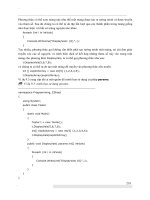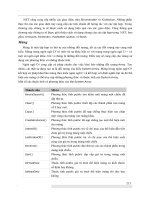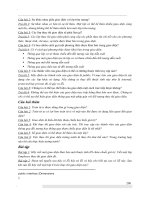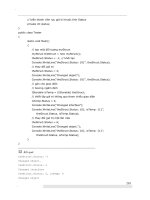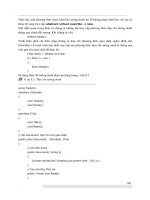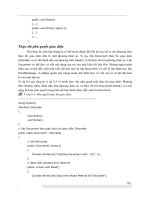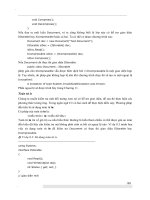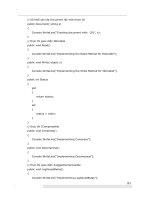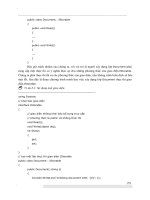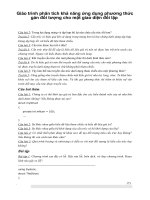Giải pháp học thích ứng trên nền tảng mạng học sâu ứng dụng nhận dạng đối tượng tham gia giao thông
Bạn đang xem bản rút gọn của tài liệu. Xem và tải ngay bản đầy đủ của tài liệu tại đây (3.63 MB, 119 trang )
MINISTRY OF EDUCATION AND TRAINING
DUY TAN UNIVERSITY
ADAPTIVE LEARNING SOLUTION BASED ON DEEP
LEARNING FOR TRAFFIC OBJECT RECOGNITION
DOCTOR OF PHILOSOPHY OF COMPUTER SCIENCE
Da Nang, 2022
MINISTRY OF EDUCATION AND TRAINING
DUY TAN UNIVERSITY
ADAPTIVE LEARNING SOLUTION BASED ON DEEP
LEARNING FOR TRAFFIC OBJECT RECOGNITION
Major: Computer Science
Code: 9480101
Da Nang, 2022
3
COMMITMENT
To the best of my knowledge, I hereby certify that all the content in the thesis
entitled "Adaptive learning solution based on deep learning for traffic object recognition" is
my own research. The figures and results of the thesis are honest, fully quoted and have not
been previously published by another.
The author's signature
ACKNOWLEDGEMENTS
First of all, I would like to express my endless thanks to my instructors. Their kindly
support and advices went through the completion process of my PhD thesis. Their
companion encouraged me to improve my work. Their instructions and motivation helped
me to grow as a research scientist.
I would also like to thank my council reviewers, members and independent scientists
for giving me contribution and brilliant comments to my thesis.
I would like to express my sincere thanks to the Board of Trustees and Board of
Rector of Duy Tan University, the teachers and officers of Duy Tan University's Graduate
School, for helping me in the process of learning and researching at University.
I also acknowledge my thankfulness to the Board of Directors of the Quang Binh
provincial Department of Information and Communications for kind assistances and
support in my work and learning so that I can achieve the results today.
Many thanks come to the research group’s members for their participation in the
published works and allowing me to use the research results for this thesis.
Finally, my deeply thanks come to my loved people and friends who were always
beside me to help me when I need for the last time. A special thanks to my family where I
got the most assistances and motivation for the whole of my life.
In spite of the fact that many efforts are made during the working process, the thesis
may remain shortcomings due to limited time and research conditions. All valuable
comments and suggestions for the thesis completion will be highly appreciated.
The author
TABLE OF CONTENTS
LIST OF FIGURES...............................................................................................................vi
LIST OF TABLES..............................................................................................................viii
LIST OF ABBREVIATIONS.................................................................................................x
INTRODUCTION..................................................................................................................1
1. Introduction.................................................................................................................... 1
2. Research goal..................................................................................................................3
3. Research method............................................................................................................ 3
4. Research subject and scope............................................................................................ 4
5. The structure of the thesis...............................................................................................5
CHAPTER 1. OVERVIEW OF ARTIFICIAL INTELLIGENCE.........................................7
1.1 Overview of artificial intelligence................................................................................7
1.1.1. Definition of artificial intelligence...........................................................................7
1.1.2 History of artificial intelligence.................................................................................7
1.2. Machine learning and identification techniques..........................................................8
1.2.1 Machine learning applications...................................................................................8
1.2.1.1 Image processing....................................................................................................8
1.2.1.2 Text analysis...........................................................................................................9
1.2.1.3 Data mining............................................................................................................ 9
1.2.1.4. Video games and robotics....................................................................................10
1.2.2 Basic recognition techniques in machine learning..................................................10
1.2.2.1 Decision tree.........................................................................................................10
1.2.2.2 Random forests..................................................................................................... 11
1.2.2.3 Boosting technique............................................................................................... 11
1.2.2.4 Support vector machine........................................................................................12
1.2.2.5 Artificial neural network...................................................................................... 13
1.3 Deep Learning and Adaptive Learning...................................................................... 15
1.3.1 Overview of Deep Learning and Adaptive Learning.............................................. 15
1.4.1.1 Deep Learning...................................................................................................... 15
1.3.1.2 Adaptive learning................................................................................................. 15
1.3.2 Deep neural network (DNN)................................................................................... 16
1.3.3 Convolution neural network (CNN)........................................................................17
1.4 Domestic and international research...........................................................................18
1.4.1 Domestic research................................................................................................... 18
1.4.2 International research.............................................................................................. 19
1.4.3..................................................................................................................................1.4.1.1 Overview
..........................................................................................................................................19
1.4.4......................................................................................................................................CHAPTER 2.
RECOGNIZING OBJECTS BY DEEP LEARNING..........................................................27
2.1 Object recognition problems...................................................................................... 27
2.1.1 Problem: Pedestrian action prediction.....................................................................27
2.1.2 Problem: Vehicle recognition.................................................................................. 29
2.2 Suggested solution......................................................................................................30
2.2.1 Solution to pedestrian recognition...........................................................................31
2.2.1.1 Extracting features and training classifier model.................................................31
2.2.1.2 Pedestrian action prediction..................................................................................32
2.2.2 Solution to vehicle recognition................................................................................35
2.2.2.1 Sequential Deep Learning architecture.................................................................35
2.2.2.2 Data augmentation................................................................................................36
2.3. Experimental evaluation............................................................................................37
2.3.1 Pedestrian detection.................................................................................................37
2.3.1.1 Extracting features and training classifier model.................................................37
2.3.1.2 Pedestrian detection and action prediction........................................................... 37
2.3.2 Vehicle recognition..................................................................................................38
2.3.2.1 Experimental data.................................................................................................38
2.3.2.2 Training CNN....................................................................................................... 39
2.3.2.3 Categorical vehicle recognition............................................................................41
1.4.5..................................................................................................................................2.4 Conclusion
..........................................................................................................................................43
1.4.6......................................................................................................................................CHAPTE
R 3: DEVELOPMENT OF ADAPTIVE LEARNING TECHNIQUE IN OBJECT RECOGNITION
..............................................................................................................................................45
3.1 Adaptive learning problem in object recognition.......................................................45
3.2 Suggested solutions.................................................................................................... 45
3.2.1 Overview of solutions..............................................................................................45
3.2.2. Analysis..................................................................................................................46
3.2.2.1 Concept Definitions of System Components........................................................46
3.2.2.2 General Structure of the System...........................................................................48
3.2.2.3 Details of the Proposed Architecture....................................................................50
3.3. Experimental evaluation............................................................................................54
3.3.1 Training CNN Model...............................................................................................54
3.3.1.1 IONet model.........................................................................................................55
3.3.1.2 PDNet model........................................................................................................ 56
3.3.2 Retraining and updating model............................................................................... 60
3.3.3 Compared results.....................................................................................................63
3.4. Conclusion.................................................................................................................65
3.2.2.4.CHAPTER 4. OPTIMIZING HYPERPARAMETERS IN ADAPTIVE LEARNING 67
3.2.2.5..............................................................4.1 Problem of optimizing hyperparameters 67
4.2. Optimization method.................................................................................................68
4.2.1 Grid search...............................................................................................................68
4.2.2 Random search........................................................................................................ 69
4.2.3 Bayesian search....................................................................................................... 70
4.3. Suggested solutions................................................................................................... 72
4.3.1. Solution overview...................................................................................................72
4.3.2. Analysis..................................................................................................................74
4.3.2.1 PDNet architecture............................................................................................... 74
4.3.2.2 Hyperparameters selection................................................................................... 75
4.3.2.3 HyperNet processing............................................................................................ 76
4.4. Experimental evaluation............................................................................................78
4.4.1 Training the initial PDNet model............................................................................ 81
4.4.2 Optimization of learning parameters, update PDNet model....................................82
4.4.3 Compare with the state - of – the - art models.........................................................91
4.5. Conclusion.................................................................................................................95
3.2.2.6...............................................CONCLUSION AND DEVELOPMENT DIRECTION 97
1. Conclusion....................................................................................................................97
2. Development direction................................................................................................. 98
3.2.2.7............LIST OF PUBLISHED SCIENTIFIC WORKS RELATED TO THE THESIS 100
3.2.2.8............................................................................................................RESFERENCES 101
3.2.2.9
3.2.2.10 LIST OF FIGURES
3.2.2.11
3.2.2.12...................................................................................................................................Fi
gure 1.1 History of artificial intelligence............................................................................... 8
3.2.2.13.................................................................................................................................Fig
ure 1.2 Classification simulation of SVM............................................................................12
3.2.2.14.................................................................................................................................Fig
ure 1.3 Illustration of neural network architecture...............................................................14
3.2.2.15.................................................................................................................................Fig
ure 1.4 Simple Deep Learning network with one layer and Deep Learning network with
multiple hidden layers.......................................................................................................... 17
3.2.2.16.................................................................................................................................Fig
ure 1.5 Architecture of a simple convolution neural network..............................................18
3.2.2.17.................................................................................................................................Fig
ure 2.1 The process of extracted features by CNN model from image dataset....................28
3.2.2.18.................................................................................................................................Fig
ure 2.2 The process of pedestrian movement prediction......................................................28
3.2.2.19.................................................................................................................................Fig
ure 2.3 Proposed vehicle detection model............................................................................30
3.2.2.20.................................................................................................................................Fig
ure 2.4 Input images and simulate rich features of image....................................................31
3.2.2.21.................................................................................................................................Fig
ure 2.5 Influence of other objects on the road on pedestrian movement prediction............32
3.2.2.22.................................................................................................................................Fig
ure 2.6 Example input image for recognition.......................................................................33
3.2.2.23.................................................................................................................................Fig
ure 2.7 Pedestrian detection with scores = 0.1 (a) and scores = 0.25 (b).............................33
3.2.2.24.................................................................................................................................Fig
ure 2.8 ROI extraction from pedestrian image.....................................................................34
3.2.2.25.................................................................................................................................Fig
ure 2.9 The order of classifications of pedestrians when there are many pedestrians on the
road in an input image..........................................................................................................35
3.2.2.26.................................................................................................................................Fig
ure 2.10 Some examples of vehicle categories.................................................................... 39
3.2.2.27.................................................................................................................................Fig
ure 2.11 Pedestrians detected and ROI extracted.................................................................38
3.2.2.28.................................................................................................................................Fig
ure 2.12 The weight values of the filter of the first convolution layer. This layer consists of
64 filters size 7x7, each of which is connected to three RGB image input channels...........40
3.2.2.29.................................................................................................................................Fig
ure 2.13 Some results of linear convolution and linear correction for the input images being
motors...................................................................................................................................41
3.2.2.30.................................................................................................................................Fig
ure 2.14 Comparison of HOG+SVM, CNN model and CNN with augmenting data..........43
3.2.2.31.................................................................................................................................Fig
ure 3.1 General flowchart of the system.............................................................................. 49
3.2.2.32.................................................................................................................................Fig
ure 3.2 Simulation of training dataset, consisting of (a) original image set and (b) labeled set
..............................................................................................................................................50
3.2.2.33.................................................................................................................................Fig
ure 3.3 Simulation of extracting Region of interest............................................................. 51
3.2.2.34.................................................................................................................................Fig
ure 3.4 PDNet model structure.............................................................................................52
3.2.2.35.................................................................................................................................Fig
ure 3.5 Simulation of tracking process of objects................................................................53
3.2.2.36.................................................................................................................................Fig
ure 3.6 Training progress of PDNet-Vehicle0 model............................................................58
3.2.2.37.................................................................................................................................Fig
ure 3.7 Training progress of PDNet-TrafficSign0 model......................................................59
3.2.2.38.................................................................................................................................Fig
ure 3.8 Comparing the accuracy of recognition results of retrained Vehicle and Traffic sign
model....................................................................................................................................64
3.2.2.39.................................................................................................................................Fig
ure 3.9 Comparison results of our proposed approach and other methods.......................... 64
3.2.2.40.................................................................................................................................Fig
ure 3.10 Comparison results by applying our Adaptive Learning to other methods............65
3.2.2.41.................................................................................................................................Fig
ure 4.1 Stimulation of searching way of Hyperparameter values by Grid Search (a) and
Random Search (b) (Source: Medium.com)........................................................................ 69
3.2.2.42.................................................................................................................................Fig
ure 4.2 Operation model of Bayesian optimization..............................................................71
3.2.2.43.................................................................................................................................Fig
ure 4.3 Gaussian process (Source: />Figure 4.4 Overall proposed model......................................................................................73
3.2.2.44.................................................................................................................................Fig
ure 4.5 Operating model of the Bayesian algorithm............................................................ 78
3.2.2.45
3.2.2.46
3.2.2.47........Figure 4.6 The confusion matrix of the accuracy of initial PDNet-Vehicle and
PDNet- TrafficSign model................................................................................................... 82
3.2.2.48Figure 4.7 The Bayesian function's objective value evaluated on objective function
evaluations............................................................................................................................87
3.2.2.49.........Figure 4.8 The confusion matrix for test data in the search process of optimal
hyperparameter and model...................................................................................................87
3.2.2.50....Figure 4.9 The confusion matrix of the accuracy of PDNet-Vehicle1 and PDNetTrafficSign1 model...............................................................................................................88
3.2.2.51. .Figure 4.10 The confusion matrix of the accuracy of PDNet-Vehicle2 and PDNetTrafficSign2 model...............................................................................................................90
3.2.2.52...Figure 4.11 Comparing the accuracy of recognition results of Vehicle and Traffic
sign model............................................................................................................................ 91
3.2.2.53.....Figure 4.12 The confusion matrix of the accuracy of AlexNet model for vehicle
recognition............................................................................................................................92
3.2.2.54Figure 4.13 The confusion matrix of the accuracy of AlexNet model for traffic sign
recognition............................................................................................................................92
3.2.2.55..Figure 4.14 The chart showing the increasing accuracy on recognition of AlexNet
model after the updated recognition model with optimal hyperparameters applied............93
3.2.2.56 Figure 4.15 The confusion matrix of the accuracy of Vgg model for vehicle
recognition . 93 Figure 4.16 The confusion matrix of the accuracy of Vgg model for traffic
sign recognition
3.2.2.57 ......................................................................................................................................
....... 94
3.2.2.58Figure 4.17 The chart showing the increasing accuracy on recognition of Vgg model
after the updated recognition model with optimal hyperparameters applied.......................94
3.2.2.59
3.2.2.60 LIST OF TABLES
3.2.2.61
3.2.2.62.................................................................................................................................Tabl
e 2.1 CNN architecture with 22 hidden layers, 1 input layer, and the final classification layer
..............................................................................................................................................36
3.2.2.63.................................................................................................................................Tabl
e 2.2 Image and label datasets of extracted and trained features......................................... 37
3.2.2.64.................................................................................................................................Tabl
e 2.3 Maximum confusion matrix for pedestrian action prediction..................................... 38
3.2.2.65.................................................................................................................................Tabl
e 2.4 Training data................................................................................................................39
3.2.2.66.................................................................................................................................Tabl
e 2.5 Training data after augmentation and balance data.....................................................39
3.2.2.67.................................................................................................................................Tabl
e 2.6 Confusion matrix of vehicle recognition using HOG and SVM.................................42
3.2.2.68.................................................................................................................................Tabl
e 2.7 Confusion matrix of vehicle recognition using CNN..................................................42
3.2.2.69.................................................................................................................................Tabl
e 2.8 Confusion matrix of vehicle recognition using CNN and data augmentation.............42
3.2.2.70.................................................................................................................................Tabl
e 3.1 The color map..............................................................................................................50
3.2.2.71.................................................................................................................................Tabl
e 3.2 The vehicle objects serving recognition by PDNet model.......................................... 55
3.2.2.72.................................................................................................................................Tabl
e 3.3 The traffic objects serving recognition by PDNet model............................................55
3.2.2.73.................................................................................................................................Tabl
e 3.4 Images and labels dataset to train PDNet1.........................................................................................................55
3.2.2.74.................................................................................................................................Tabl
e 3.5 Global accuracy of IONet model.................................................................................56
3.2.2.75.................................................................................................................................Tabl
e 3. 6 Accuracy of objects of IONet model..........................................................................56
3.2.2.76.................................................................................................................................Tabl
e 3.7 Image datasets for testing PDNet-TrafficSign model..................................................57
3.2.2.77.................................................................................................................................Tabl
e 3.8 Image datasets for testing PDNet-Vehicle model........................................................57
3.2.2.78.................................................................................................................................Tabl
e 3. 9 Image datasets for training PDNet-Vehicle................................................................ 57
3.2.2.79.................................................................................................................................Tabl
e 3.10 The confusion matrix of the accuracy of PDNet-Vehicle0 model.............................58
3.2.2.80.................................................................................................................................Tabl
e 3.11 Image datasets for training PDNet-TrafficSign.........................................................59
3.2.2.81.................................................................................................................................Tabl
e 3.12 The confusion matrix of the accuracy of PDNet-TrafficSign0 model.......................59
3.2.2.82.................................................................................................................................Tabl
e 3.13 The configuration of the device to test the process speed......................................... 60
3.2.2.83.................................................................................................................................Tabl
e 3.14 Image data for retraining PDNet-Vehicle0 model......................................................61
3.2.2.84.................................................................................................................................Tabl
e 3.15 Image data for retraining PDNet-TrafficSign0 model...............................................61
3.2.2.85.................................................................................................................................Tabl
e 3.16 Image data for retraining PDNet-Vehicle1model.......................................................61
3.2.2.86.................................................................................................................................Tabl
e 3.17 Image data for retraining PDNet-TrafficSign1 model...............................................61
3.2.2.87.................................................................................................................................Tabl
e 3.18 The confusion matrix of the accuracy of PDNet-Vehicle1 model.............................62
3.2.2.88.................................................................................................................................Tabl
e 3.19 The confusion matrix of the accuracy of PDNet-TrafficSign1 model.......................62
3.2.2.89.................................................................................................................................Tabl
e 3.20 The confusion matrix of the accuracy of PDNet-Vehicle2 model.............................62
3.2.2.90.................................................................................................................................Tabl
e 3.21 The confusion matrix of the accuracy of PDNet-TrafficSign2 model.......................63
3.2.2.91.................................................................................................................................Tabl
e 3.22 Comparing the processing speed on traffic sign and vehicle sign between our
proposed model and AlexNet,Vgg model............................................................................65
3.2.2.92.................................................................................................................................Tabl
e 4.1 PDNet model structure and parameters.......................................................................74
3.2.2.93.................................................................................................................................Tabl
e 4.2 Hyperparameters in the training process of CNN (Training option)...........................76
3.2.2.94.................................................................................................................................Tabl
e 4.5 The object for PDNet model recognition....................................................................78
3.2.2.95.................................................................................................................................Tabl
e 4.3 Image datasets for testing the PDNet-Vehicle model..................................................79
3.2.2.96.................................................................................................................................Tabl
e 4.4 The object for PDNet model recognition....................................................................79
3.2.2.97.................................................................................................................................Tabl
e 4. 6 Image datasets for testing PDNet-TrafficSign model.................................................80
3.2.2.98.................................................................................................................................Table 4.7 model
Parameter domain values.....................................................................................................80
3.2.2.99.................................................................................................................................Table 4.9 Image
datasets for training initial PDNet-Vehicle...........................................................................81
3.2.2.100...............................................................................................................................Table 4.8 The
configuration of the device...................................................................................................81
3.2.2.101
3.2.2.102
3.2.2.103...............................................................................................................................Table 4.10 Image
datasets for training initial PDNet-TrafficSign....................................................................81
3.2.2.104...............................................................................................................................Table 4.11
Image data (Data-Vehicle0) for searching hyperparameters and the PDNet- Vehicle1 model 83
3.2.2.105...............................................................................................................................Table
4.12 Image data (Data-TrafficSign0) for searching hyperparameters and the PDNet- TrafficSign1
model....................................................................................................................................83
3.2.2.106...............................................................................................................................Table
4.13 Found optimal hyperparameter values of PDNet-Vehicle1 and PDNet- TrafficSign1 model
..............................................................................................................................................87
3.2.2.107...............................................................................................................................Table
4.15 Image data (Data-TrafficSign1) for searching hyperparameters and the PDNet- TrafficSign2
model....................................................................................................................................89
3.2.2.108...............................................................................................................................Table
4.14 Image data (Data-Vehicle1) for searching hyperparameters and the PDNet- Vehicle2 model
..............................................................................................................................................89
3.2.2.109...............................................................................................................................Table
4.16 Found optimal hyperparameter values of PDNet-Vehicle2 and PDNet- TrafficSign2 model
..............................................................................................................................................89
3.2.2.110...............................................................................................................................Table 4. 17
Results of proposed methods compared to those of the Chapter 3......................................95
3.2.2.111 LIST OF ABBREVIATIONS
3.2.2.112
3.2.2.113
3.2.2.114 Abb
3.2.2.116 AI
3.2.2.117
E
xplanation
Artificial Intelligence
3.2.2.118 HA
3.2.2.119
Human Action Recognition
3.2.2.120 ML
3.2.2.121
Machine Learning
3.2.2.122 DL
3.2.2.123
Deep Learning
3.2.2.124 AL
3.2.2.125
Adaptive Learning
3.2.2.126 CN
3.2.2.127
Convolution Neural Network
3.2.2.128 NN
3.2.2.129
Neural Network
3.2.2.130 DN
3.2.2.131
Deep Neural Network
3.2.2.133
Artificial Neural Network
3.2.2.135
Support Vector Machine
3.2.2.136 RF
3.2.2.137
Random Forest
3.2.2.138 ACF
3.2.2.139
Aggregate Channel Features
3.2.2.140 ITS
3.2.2.141
Intelligent Transportation Systems
3.2.2.142 ROI
3.2.2.143
Region of interest
3.2.2.144 SaaS
3.2.2.145
Software-as-a-Service
3.2.2.146 AD
3.2.2.147
Advanced Driver Assistance Systems
3.2.2.149
Histograms of Oriented Gradients
3.2.2.151
Auto Vehicle
3.2.2.115
reviation
C
N
N
3.2.2.132 AN
N
3.2.2.134 SV
M
AS
3.2.2.148 HO
G
3.2.2.150 AV
15
3.2.2.152
3.2.2.153
3.2.2.154 INTRODUCTION
1. Introduction
3.2.2.155
3.2.2.156 Artificial intelligence (AI) is intelligence demonstrated by an artificial
system. Artificial intelligence is everywhere today such as office applications, automatic
answering systems, intelligent traffic management, smart home management, etc. Since the
Computer hardware systems became increasingly capable, artificial intelligence has made
great progress, applied more widely in all fields of life and society.
3.2.2.157 Artificial intelligence focuses on developing algorithms and applications
that support human in decision making or self- decision making in the process of data
identifying and acquiring. Object detection, Object action recognition and Human action
recognition are one of the research targeted directions such as security surveillance
systems, security, manual remote control systems, blind assist systems, sports data analysis
systems, automated robots, self-driving cars [1, 2, 3, 4, 5], and so on. There have been
many studies proposing many different solutions to artificial intelligence development such
as heuristic algorithm, evolution algorithm, Support Vector Machine algorithm, Hidden
Markov Model algorithm, expert method, neural network method, [6, 7, 8], etc. Traditional
solutions, yet all require human intervention and huge amounts of data to analyze and store
but low accuracy and limited identification cases.
3.2.2.158 To overcome those shortcomings, machine learning with focusing on Deep
Learning Method (Deep Learning) is now being applied in artificial intelligence in terms of
object detection and action recognition.
3.2.2.159 Deep Learning has been a hotly debated AI topic. As a small category of
machine learning, Deep Learning focuses on solving issues related to artificial neural
networks in order to upgrade technologies such as voice recognition, image recognition and
natural language processing. In just a few years, Deep Learning has promoted progress in
a variety of fields which are used to be very difficult toartificial intelligence
researchers such as Object Perception, Machine Translation, voice recognition, etc.
3.2.2.160 However, despite of the fact that issues related to AI were solved, Deep
Learning has still remained limitations that need to be settled.
- Firstly, to create a system capable of identifying a variety of objects, a huge amount of
16 computers to learn. This process takes
input data is required by Deep Learning to enable
time with assistance of an extremely large processor which can be only processed by a
large server system.
- Secondly, Deep Learning is still unable to recognize complex things like common social
contacts. It, also, has trouble with detecting similar things because of having no technology
good enough helping artificial intelligence to draw those recognition logically. Besides,
integration of abstract knowledge into machine learning systems seem to be the challenging
issues, such as information about what object is, what it is used for, how people use it, so
on. In other words, machine learning has not acquired the usual knowledge like human yet.
3.2.2.161 The question is “How can a machine learning system learn the knowledge,
select and update appropriate knowledge and then build a binding, stringed data set like
human by itself?”. Research on Adaptive Learning [9, 10, 11, 12, 13, 14] can be a solution
to improve Deep Learning' limitations, exploring issues that Deep Leaning has not been
able to do.
3.2.2.162 A comprehensive Adaptive Learning model will make an auto robot system
being capable of self-learning
and
self-intelligence
that
emulate the
way
the
human brain work. Under the device’s operation, the intelligence of the system will
increase over time. Accordingly, appropriate data will be automatically selected by the
system with its retraining of the model and replacing of the old model
3.2.2.163 The proposed Adaptive Learning model could be promisingly applied in
many different Auto Robot systems. Yet, in this research of a doctoral thesis, studying and
experiment will be conducted on self-driving vehicles to simulate anoperation process of an
auto robot. Recognition objects of self-driving vehicles include objects in traffic such as
other vehicles (motorcycles, cars, trucks, passenger cars, etc.), pedestrians, traffic signs,
roadbed, roadside, etc.
2. Research goal
3.2.2.164
3.2.2.165 The thesis goal is to study on artificial intelligence, the methods and
algorithms that have been applied, evaluating the limitations of the current methods in
order to propose improved solutions, enhancing the efficiency and accuracy of AI applied
in object detection.
- Study, analyze and evaluate traditional methods: Support Vector Machine, Hidden Markov
Model, Neural network, and so on.
17
- Study and evaluate the application of Deep Learning
in classification and object detection
in traffic (Pedestrians, traffic vehicles, traffic signs, etc.).
- Propose solutions to enhance the performance capacity of the Deep Learning model based
on Adaptive Learning approach with conducting experiments of Adaptive learning and
hyperparameters on self-driving vehicle (ADAS).
- Develop data sets for training and recognizing objects in traffic.
3.2.2.166
3. Research method
3.2.2.167
- Method of information collection: Collecting overview materials of basic foundation
algorithm and AI, documents and articles about Deep Learning, Adaptive Learning and
object detection. The experimental data were collected from real-time traffic cameras and
from the videos on the internet.
3.2.2.168 -Comparison method: Summary and comparison between the obtained
documents to provide an overview of the methods, advantages and disadvantages of those
methods as well.
- Analysis method: Analyze the algorithms, their operation and characteristics. The
effectiveness of the algorithms applied to specific cases is evaluated and analyzed to get the
best results.
- Expert method: Consult from AI experts to complete the area need to be studied.
- Experimental method: Installing and testing algorithms applied to each method for a better
understanding. From this, the advantages and disadvantages of each method are then
evaluated and verified.
- Conduct experiments on Google's machine learning open-source system (TensorFlow),
MathWorks (Matlab) to have comparison with the results of research experiments.
- Collect and establish real empirical data sets (Objects in traffic: pedestrians, vehicles,
traffic signs, etc..) which are used for training and testing the proposed algorithms. Data
sets of images are collected from actual photos on road or from videos on the internet.
- Install research results on the system to prove experiment.
4. Research subject and scope
- Research subject
3.2.2.169 + Deep Learning method
3.2.2.170 + Adaptive Learning method
18
- Research scope
3.2.2.171 + Some machine learning methods.
3.2.2.172 + Deep Learning method and Adaptive Learning method
3.2.2.173 + Propose solutions to enhance on-road object detection quality of selfdriving car system.
3.2.2.174 + Study and propose Adaptive Learning solution which is applied in onroad object detection.
3.2.2.175 + Create data and experiment, analyze results.
5. The structure of the thesis
3.2.2.176
3.2.2.177
3.2.2.178
3.2.2.181
3.2.2.179
Chapter and title
Chapter 1: Overview of artificial
R
elevant
scientific
publications
Rele
vant scientific
Contribution
3.2.2.180
3.2.2.183
3.2.2.184
intelligence
An
overview
of
artificial
intelligence and traditional algorithms includes
decision tree, random forest, Support vector
machine, and Artificial neural network. Domestic
and international research on on-road object
detection and Adaptive Learning solution for
self-driving vehicle systems.
3.2.2.185
Chapter 2: Identifying objects
by Deep Learning
3.2.2.186
Proposes solution to on-road object
detection by Deep Learning: pedestrians,
vehicles
None
3.2.2.182
3.2.2.187 - Deep Learning in pedestrian
action prediction
3.2.2.188 P - Deep Learning in vehicle
P 1.1
classification
3.2.2.189 P
P 1.2
3.2.2.190 P
P 1.3
Chapter 3: Developing Adaptive
Learning techniques in object recognition
3.2.2.192
Basing on the research results stated
in Chapter 2, the Adaptive Learning solution of
self-driving vehicle system data is continuously
proposed. The proposed model is capable of selflearning and self-intelligence without any human
intervention
3.2.2.191
3.2.2.193 3.2.2.199
Adaptive
learning techniques in vehicle,
3.2.2.194 traffic sign recognition and
advanced driver assistance
3.2.2.195 systems
3.2.2.196
3.2.2.197
3.2.2.198
PP 1.4
19
Chapter 4: Optimization of
hyperparameter set in Adaptive Learning
3.2.2.201
Basing on the proposed model
mentioned in Chapter 3, the Adaptive Learning
solution of algorithms and parameters is
3.2.2.202
continuously studied, improving
3.2.2.200
3.2.2.203 3.2.2.207
Adaptive
learning through optimization
3.2.2.204 of the training hyperparameter
set based on a new dataset
related to traffic sign and
3.2.2.205
vehicle recognition
3.2.2.206
PP 1.5
3.2.2.208
efficiency
and on-road
object detection accuracy.
3.2.2.209
3.2.2.210
3.2.2.211
3.2.2.212
3.2.2.213 CHAPTER 1. OVERVIEW OF ARTIFICIAL INTELLIGENCE
3.2.2.214
3.2.2.215
3.2.2.216 In this chapter, we investigate overview of artificial intelligence and
traditional algorithms includes decision tree, random forest, Support vector machine, and
Artificial neural network. Domestic and international research on on- road object detection
and Adaptive Learning solution for self-driving vehicle systems.
1.1 Overview of artificial intelligence
3.2.2.217
1.1.1. Definition of artificial intelligence
3.2.2.218
3.2.2.219 There have been many different definitions of artificial intelligence, or AI
in the world, specifically:
• By popular, artificial intelligence is is intelligence demonstrated by any artificial system.
The term is often used to refer to computers with unspecified purpose and the science of
theories and applications of artificial intelligence.
• According to Bellman, artificial intelligence is the automation of activities that we
associate with human thinking, activities such as decision-making, problem solving,
learning, etc.
• Rich and Knight: “Artificial intelligence is the study of how to make computers do things
at which, at the moment, people are better''.
3.2.2.220 Historically, each definition has its own right, but for simplicity we can get
the idea of artificial intelligence as a computer science. It was built on a solid theoretical
foundation and can be applied to automation of the intelligent behavior by computers. It
makes computers acquire the human intelligence such as thinking, decision-making,
problem solving, learning and self-adapting.
3.2.2.221 1.1.2 History of artificial intelligence
3.2.2.222
3.2.2.223 The history of artificial intelligence [15, 16, 17] has gone over many
different stages of development, as shown in Figure 1.1.
3.2.2.224
3.2.2.225
3.2.2.226
3.2.2.227
3.2.2.228
3.2.2.229
Figure 1.1 History of artificial intelligence (Source: />
1.2. Machine learning and identification techniques
3.2.2.230
3.2.2.231 As an AI subfield, machine learning uses algorithms that enable computers
to learn from data to perform tasks instead of being explicitly programmed [18].
1.2.1 Machine learning applications
3.2.2.232
1.2.1.1 Image processing
3.2.2.233 Image processing problem solve issues of analyzing information from
images or performing some transformations. Some examples are:
•
Image tagging, like Facebook, an algorithm that automatically detects your face and your
friends' photos. Basically, this algorithm learns from photos you've tagged yourself before.
•
Optical Character Recognition (OCR) is an electronic conversion of the typed, handwritten
or printed text images into machine-encoded text. The algorithm must learn to recognize
what the snapshot of a character is.
•
Self-driving cars, part of the mechanism used here is image processing. A machine learning
algorithm enables self-driving cars to detect road edges, signs or obstacles by looking at
each video frame from the camera.
•
•
1.2.1.2 Text analysis
•
Text analysis is a work of transforming or classifying free texts. The texts here can
be Facebook posts, emails, chats, documents, etc. Some common examples are:
•
Spam filtering is one of the most popular spam text classification applications. Text
classification, here, is to identify the subject definition of a text. The spam filter can also
“learn” what each user views as spam based on the user identifying email message and its
subject.
•
Sentiment
Analysis
learns
how
to
classify
an
expression as positive ,
negative, or neutral
•
Information Extraction is the process of extracting information from textual sources, learn
how to useful information, address, a person's name, a keyword, etc. for ex.
1.2.1.3 Data mining
•
Data mining is a process of discovering valuable information or making
predictions on sets. Each record is an object to learn and each column is a feature. The value
of a column of new record can be predicted based on the learned records or the records can
be grouped. Data mining applications are:
•
Anomaly detection is a technique for finding an unusual point, credit card fraud detection
or, for example. A suspicious transaction may be discovered based on a change in consumer
normal behavior.
•
Association rules, for example, in a supermarket or on an e-commerce site. It can be found
which items customers often buy together. In other words, which item does your customer
usually buy next when buying item? Such information can be used as the basis for
decisions about marketing activities
•
Grouping, for example, in a SaaS platform, users are grouped by their behavior or by
profile information.
•
Predictions, the value columns (of a new record in the database). For example, the price of
an apartment can be predicted based on the previous price data.
•
1.2.1.4. Video games and robotics
•
Video games and robotics are a big field where machine learning made its
contribution to. If a character moves and needs to avoid obstacles in the game, machine
learning can learn and does this task by using Reinforcement learning. Accordingly,
reinforcement learning by machine aims at solving the above task. Reinforcement learning
is negative if colliding obstacles. It is positive if reaching the destination.
1.2.2 Basic recognition techniques in machine learning
•
•
The ability to apply AI methods combined with image processing to object
recognition is one of the most important issues of computer vision. machine learning
technique is divided into two types that are supervised machine learning and unsupervised
machine learning. The supervised machine learning techniques include decision trees,
neural network, SVM, boosting, random forests, etc. Under the supervised machine
learning, the classification is usually based on a sample dataset to be labeled in layers by
"experts" to analyze and develop recognition model. The sample data set to be learned is
called the training dataset. The analyzing and developing process of object is called a
training process of recognition machine or model training. In contrast, under unsupervised
method unlabeled data, algorithm itself do its classification and against data which is not
labeled. Its identification of object layer is based on analysis and statistics from the input
data set.
1.2.2.1 Decision tree
•
Decision trees are a specific field of research in machine learning. Decision tree
techniques are widely used in the fields of knowledge exploitation and pattern recognition
[19]. A decision tree is a predictive model, developed on a tree structure, used to layer data
samples based on a series of rules. In these tree structures, leaves represent
decisions
and
classification
branches represent conjunctions of features that lead to those
classification decisions.
•
A decision tree can be trained by dividing the training data set into subsets for test
of a single attribute value or a group of attributes. Classification can be described as simple
classification combinations by using mathematical deductive techniques. The training of
classification model is the development process of a decision tree.
1.2.2.2 Random forests
•
Random forests (RF)operate by constructing a multitude of decision trees with
random selection of features. Random sub-multitude selection of features is not necessarily
separate. Thus, selection of features and tree construction are made by the random
algorithm. Random forests was created by Tin Kam Ho [20] in 1998 published on IEEE
Journal.. Similarly, random forests are also a form of supervised algorithm. RF algorithm
can be used for both classification and regression problems, capable of handling problems
with lack of value. More trees in forests enable the problem with over-fitting data to be
solved. Random forest techniques are widely used in the field of computer vision and
object classification.
1.2.2.3 Boosting technique
•
Boosting technique is a machine learning ensemble algorithm by constructing
multiple classifiers at the same time which can, then, be combined by weight. Each
component classifier is called the weak classifier. Weak classifiers are combined to
generate a one strong classifier. AdaBoost (Adaptive boosting) proposed by Freund and
Schapire[21] in 1999 is one of the popular boosting algorithms. AdaBoosting is a nonlinear
strong classifier, which works on the principle of weak classifiers combination by weights
to generate a stronger classifier of adaptive type (with data samples).Accordingly,
AdaBoost uses weights to mark difficult-to-categorize patterns. Meanwhile the easy
classifications contain
a smaller impact value, the deeper the levels of the weak
classification are, the more the classifier focuses on difficult-to-categorize samples. That is,
during the training, each weak classifier updates its weight in the direction of decreasing
the weight of the correct classification samples (easy samples) and increasing the weight of
the weak classifications thereafter. Based on this idea, the later classifiers can handle
primarily on difficult samples that the previous classifier can’t. Finally, weak classifiers are
combined by their weight depending on classification accuracy to generate a final strong
classifier.
1.2.2.4 Support vector machine
•
The support-vector machine (SVM) is a supervised learning algorithm which is
proposed by Corinna and Vapnik [22] in 1995. SVM was first designed for classification
problem, expanded for application of various multilayer classifications [23, 24]later. The
SVM algorithm conducts training to develop model for data sample classification by
classes for each training data sample set of two predefined types. An SVM model is a
representation of vectors that support classification in multi-dimensional space and the
choice of hyperplane to classify between two classes so that the maximum distance from
the training data samples (points in n-dimensional space) to the classification plane (Figure
1.2).Samples for classification must be represented in the same space and SVM is classified
into one of two classes depending on the specific value of the data sample on which side of
the classification super plane.
Figure 1.2 Classification simulation of SVM (Source: )
•
•
Up to now, SVM is one of the most widely used classification methods in the field
of computer science and data analysis. SVM works effectively on large data sets and in a
large number of dimensions, especially applied to classifications of image data, text, voice,
etc. SVM is capable of being applied to many different kernel functions and can be
classified by linear or non-linear methods. In fact, SVM reaches to a quietly high accuracy
compared to other traditional machine learning techniques.
1.2.2.5 Artificial neural network
•
•
Artificial neural network (ANN) is often referred to as neural network. A neural
network is vaguely inspired by a biological neural network. ANN architecture consists of
the nodes (called neutral) and a set of arcs (called edges)(Figure 1.3). Set of the
connections is organized into layers, including input layer, output layer. In between them
are hidden layers. Each arc connects two pairs of neural including an input and an output to
transmit information and process new values for output. The propagation function, with its
corresponding weight set, presents the relationship between nodes. Normally, the NN
architecture is developed in advance and weights are then defined during the training.
However, some types of networks are capable of adapting to real data and its architecture
can be changed by itself thank to information during its learning. Such networks are
Multilayer neural network- MLNN and Self organizing maps- SOM.
•
Capable of self-learning in neural networks is one of the important components of
NN [25]. A neural network is not only a complex system but also a complex adaptive one,
